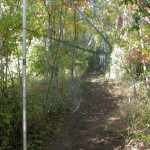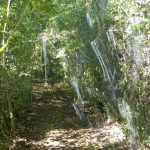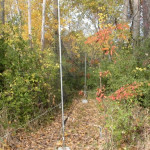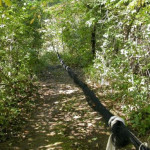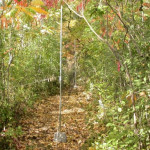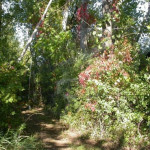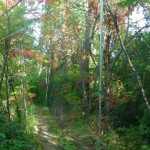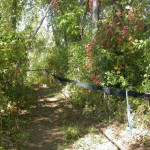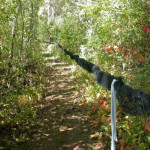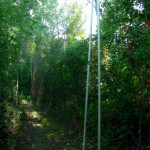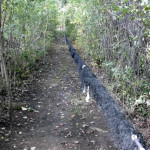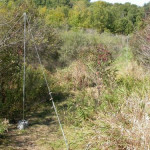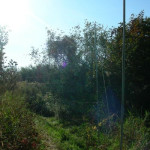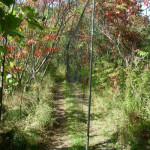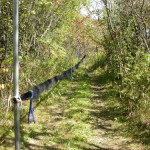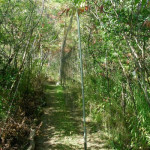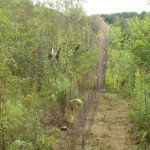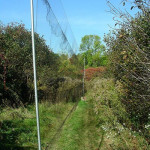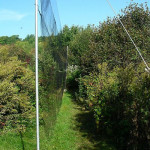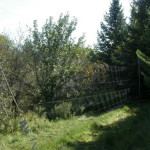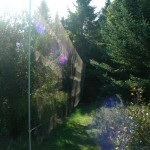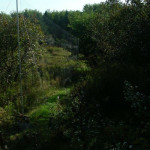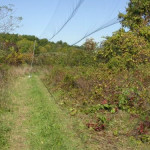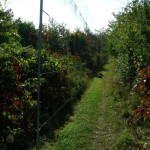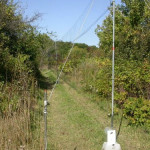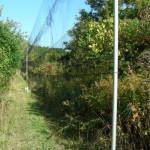MBO currently has 25 designated net locations assigned to 9 groups, used at different times of year. These are shown below. Several of these have been adopted by net sponsors, whose donations are important to keeping a full supply of nets in good condition.
* Note that the photographs of the nets below can be seen full-size by clicking on any of the thumbnail images.
Back Ponds
Net line B
The B net line is just north of the banding cabin, along a ridge that follows the edge of the duck ponds. It consists of four nets interspersed with the N nets (B1-B2-N1-N2-N3-B3-N4-B4). Typically the B nets are used for diurnal banding, and the B and N nets are used together for owl banding to create a continuous 104-metre long net along the ridge.
B1 and B2 are within a sumac stand and catch many kinglets, chickadees, vireos, and sparrows. B3 is in a gap with some taller cottonwood trees alongside, and tends to catch sparrows, robins, and other somewhat larger birds. B4 is again near sumacs, but surrounded mostly by buckthorns, and yields a fair number of kinglets, chickadees, and warblers.
- Net B1 in late September 2005
- Net B1 in mid-October 2004
- Net B2 in late September 2005
- Net B3 in late September 2005
- Net B3 in mid-October 2004
- Net B4 in late September 2005
- Net B4 in mid-October 2004
Net line N
The N net line is just north of the banding cabin, along a ridge that follows the edge of the duck ponds. It consists of four nets interspersed with the B nets (B1-B2-N1-N2-N3-B3-N4-B4). Typically the B nets are used for diurnal banding, and the B and N nets are used together for owl banding to create a continuous 104-metre long net along the ridge.
N1 and N2 are in a partly open gap between a sumac stand and a buckthorn stand, with some open exposure to the ponds on the west side, but are nonetheless mostly shaded thanks to several tall cottonwoods along the ridge. N3 and N4 have denser vegetation on both sides, mostly buckthorn and some sumac. All N nets have proven effective at catching owls, and when opened during the day have also produced good numbers of sparrows, warblers, and chickadees
- Net N1 28 Sep 2005 (by Marcel Gahbauer
- Net N1 20 Sep 2007 (by Marie-Anne Hudson)
- Net N2 (above, 28 Sep 2005 by Marcel Gahbauer)
- Net N3 28 Sep 2005 (by Marcel Gahbauer)
- Net N3 20 Sep 2007 (by Marie-Anne Hudson)
- Net N4 (above, 28 Sep 2005 by Marcel Gahbauer)
Net line H
The H nets are the newest addition to MBO, with H1 installed in late August 2005 and H2 following the next fall. The first net begins just west of the banding cabin, leading to the south end of the back ponds, with hawthorns on either side of the lane. It catches a surprising diversity of species in good numbers, including sparrows, warblers, vireos, and thrushes. The second is a bit to the southwest, nestled between hawthorns, parallel to the main path leading down to Stoneycroft Pond.
- Net H1 (above, 28 Sep 2005 by Marcel Gahbauer looking north toward the pond; below, 20 Sep 2007 looking south toward the windmill by Marie-Anne Hudson)
- Net H2 (above, 20 Sep 2007 looking east, by Marie-Anne Hudson)
- Net H2 (above, 20 Sep 2007 looking east, by Marie-Anne Hudson)
Stoneycroft Ponds
Net line C
The C net line is located in the sumac stand at the north end of Stoneycroft Pond, an area frequented by a wide diversity of sparrows, warblers, and other small songbirds. The nets are located within natural gaps in the sumac stand.
- Net C1
- Net C1
- Net C2
- Net C2
Net line G
The two G nets were added to MBO in August 2005. G1 is perpendicular to the shoreline of Stoneycroft Pond, and slopes gently down toward it. On either side are buckthorns and other shrubs only slightly taller than the net. This net can be exceptional for warblers, catbirds, and orioles early in fall migration. Across the census path from G1 is G2, extending further up the slope, between hawthorns, buckthorns, and elms. It is one of the best vireo nets at MBO and also catches many sparrows and warblers. However, due to the distance from other nets, G is not operated as a standard part of the migration monitoring protocol.
- Net G1 full of birds on a busy morning in late August 2005 (photo by Marcel Gahbauer)
Inner Loop
Net line A
Net A1 was added to MBO at the start of the spring 2005 and has since then often been the most productive of all nets on site. Located in a natural gap between apple trees and hawthorns, A1 is at the edge of the clearing in the centre of MBO, but also close to Stoneycroft Pond. Yellow Warblers, Purple Finches, and Brown Thrashers seem to have a particular preference for A1, but there are relatively few species among those we have banded that have not visited it. Owing to the success of this location, net A2 was added off the far (southeast) end of A1 in the fall of 2006, among dense raspberry bushes along the edge of a large sumac grove.
- Net A1
- Net A1
- Net A2
Net line E
Net E1 is located a bit east of Stoneycroft Pond, tucked between the edge of a spruce grove and a dense mixed stand of apples and hawthorns. It is most notable for capturing large numbers of kinglets and Palm Warblers, as well as occasional other warblers, chickadees, and cardinals. A second net, E2, was added perpendicular to the north end of E1 in the fall of 2006.
- Net E1
- Net E1
- Net E2
Net line D
The D net line was initially the most productive group after A1, though over time some other nets (such as H) have tended to be more productive. It is comprised of three consecutive nets totaling 36 metres, and since 2008 also includes a single perpendicular net that cuts through the shrubs toward the edge of Stoneycroft Pond. Though much more in the open than the other nets, they are effective because only a narrow row of shrubs (to the west) separate them from Stoneycroft Pond, where much bird activity is concentrated. Sparrows, buntings, and finches are particularly often caught in these nets, but they are also good for warblers, chickadees, kinglets, and occasionally even hawks.
- Net D1
- Net D1
- Net D3
- Net D3
Winter nets
Net line V
The V nets are arranged as an open-ended square at the edge of the small wooded area a bit south of the banding station. They are used only for winter banding. During winter, six feeders are stocked within the net square. The vegetation within the square is mostly hawthorns. V2 runs along the edge of the woods, with spruces and balsam firs along its length on one side. V1 and V3 are perpendicular to V2, and V4 is parallel to it on the far side of the hawthorns. V3 and V4 are the most exposed of the nets, but overall the area is quite well sheltered by the conifers.
(Photographs to come)


